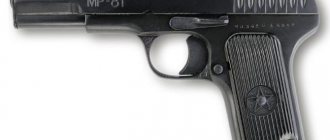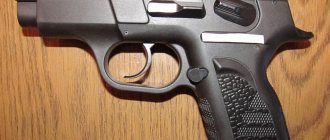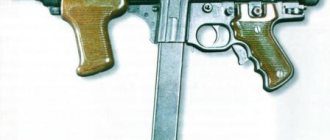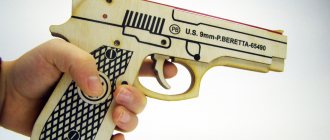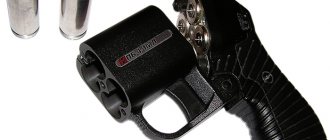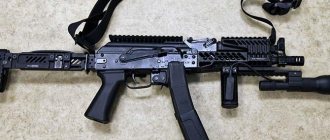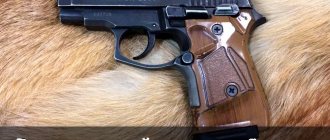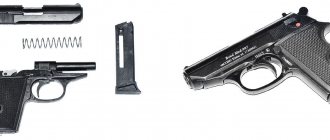Pistol Arsenal “Strike One” / “Strizh” (Russia – Italy)
Arsenal "Strike One" / "Swift" pistol (prototype demonstrated at IWA 2012)
Arsenal “Strike One” / “Swift” pistol, incomplete disassembly. The photo clearly shows the barrel assembly with the locking cylinder and the locking grooves in the bolt
Arsenal “Strike One” / “Swift” pistol, bolt, barrel and separate locking cylinder
Arsenal “Strike One” / “Swift” pistol with an extended barrel in the hands of the author of this site
9mm Strizh pistol, Russian-made, prototype of series 4, prepared for testing for the Russian Armed Forces. June 2012. photo by Arsenal Firearms
Serial Strike One pistol produced in Italy by Arsenal Firearms
| USM | With pre-cocked striker |
| Caliber | 9x19 Luger/Parabellum, 9x21 IMI, .357SIG, .40SW |
| Weight without cartridges | 750 g (with polymer frame) |
| Length | 210 mm |
| Barrel length | 128 mm |
| Magazine capacity | 17 rounds (9mm), 13 rounds (.40, .357) |
The “Strike One” pistol, also known as the “Swift”, was first shown to the general public at the IWA-2012 exhibition, held in March 2012 in Nuremberg, Germany. The “Strike” / “Strike One” pistol was developed by the young company Arsenal Firearms, which has headquarters in Russia and production facilities in Russia, Italy and Austria. The Arsenal company is headed by the famous Russian weapons collector Dmitry Streshinsky and the Italian Nicola Bandini. The production of Swift pistols was supposed to be carried out at all three sites in order to be able to supply it to different markets and different users, taking into account the restrictions of the legislation of different countries. The Strike One pistol is marketed as a weapon for the military and law enforcement, but it can also be used as a sporting weapon and as a weapon for self-defense of citizens (where permitted by law). The main difference between the “Strizh” / “Strike One” pistols and its competitors is the low location of the barrel axis relative to the hand holding the weapon and the minimal mass of parts moving in a vertical plane, which makes it possible to more effectively control the recoil of the weapon and the toss of the barrel during high-speed shooting. To achieve such properties, the pistol uses an original automation scheme with a movable barrel, the origins of which can be found in the designs of Louis Schmeisser, created by him at the beginning of the 20th century at the Theodor Bergmann factory (Bergmann “Mars” pistol).
The Strizh pistol in the version chambered for 9x19 in 2012-2013 underwent official tests at the Central Research Institute TOCHMASH (Klimovsk, Russia), but for various reasons it did not completely pass them. As a result, mass production of the pistol under the designation Strike One was launched in Italy at the facilities of Arsenal Firearms, and since 2015, the Strike One pistol has been quite successfully sold around the world. The Russian “branch” of this project, the “Strizh” pistol, has not yet received development.
The Strike One pistol uses a polymer or ergal frame (with a steel liner) in combination with several barrel-breech-magazine kits to accommodate a variety of 9-10mm caliber cartridges. The automatic operation of the pistol uses the recoil of the barrel during its short stroke, while the recoil of the barrel occurs strictly in the longitudinal direction, without any distortion or rotation. Locking the barrel bore (barrel engagement with the bolt) is ensured by a separate Y-shaped locking part. The upper part of the locking part (“fork”) covers the barrel from below and from the sides, entering a vertical groove on its surface. This groove allows the locking part to move up and down relative to the barrel, but does not allow longitudinal movement. On the outer surface of the “fork” there are lugs that fit into cutouts on the inner surface of the bolt. The lower part of the “fork” has an inclined through groove through which a transverse pin passes, inserted into the weapon frame. Before firing, the barrel and bolt are in the extreme forward position, and the interaction of the transverse pin and the groove in the locking cylinder holds it in the upper position, so that the lugs on its outer surface rigidly engage the barrel and bolt. After the shot, the barrel and bolt begin to roll back together, while the interaction of the transverse pin and the inclined groove in the locking cylinder causes the latter to decline relative to the barrel, so that after a short rollback its lugs disengage with the bolt. After disengaging the bolt and barrel, the latter is stopped by the impact of its breech on the frame liner, and the bolt continues to move backward by inertia, removing and ejecting the spent cartridge case. During the recoil, the bolt sends a new cartridge from the magazine into the barrel, and then begins to push the barrel forward. The movement of the barrel causes the locking part to rise upward, again firmly engaging the barrel with the bolt for the next shot. The trigger mechanism of the pistol “Strizh” / “Strike One” is striker-fired. The mainspring of the firing pin is partially cocked during the rollback and retraction of the bolt, and is cocked to the firing position only when the trigger is pressed (similar to Glock pistols). The cartridges are fed from box-shaped double-row magazines with cartridges exiting in one row. The magazine release buttons are located on both sides of the weapon handle, the bolt stop lever is located on the left side of the frame. The pistol frame has replaceable butt pads. The pistol has an integral Picatinny rail on the frame under the barrel for mounting various accessories. In addition to the basic version, based on the “Strike” / “Strike One” pistol, a “carbine” version with an elongated barrel 30 cm long has been developed, on which branded accessories can be installed in the form of a forend with additional Picatinny rails or an extended adapter with a butt
Pistol "Black Swift", or Strike One
This year, among the new domestic weapons, the “Black Swift” pistol, also known as “Strike One,” attracts special attention. The weapon is really quite interesting, both from the point of view of the fact that it is just a new pistol, and from the point of view of the way the barrel is locked. Of course, one can argue long and hard about whether this type of weapon can be considered domestic, but why do we need all this demagoguery? The important thing is that there is a weapon, which means we need to figure out what kind of Black Swift bird it is, and what is it better for use.
The “Black Swift” pistol, or Strike One for the foreign market, is the brainchild of Arsenal Firearms, which calls into question the fact that this is a domestic weapon. Still, the concept of “domestic” implies not only that the idea was born in the head of our compatriot, but also that weapons should be produced domestically. However, many question whether the domestic arms industry could master the production of this pistol in high quality. I think that I could. You can even do the impossible, with the help of a long lever and an obscene word, and if you also interest everyone in high-quality production - from the plant director to the cleaning lady, not only financially if all requirements are met, but also in the form of depreciation, or even dismissal , in case of deviation from the norm, the quality will increase to the skies. They will immediately remember the sheathed new machines, there will be a lot of people who want to learn how to work on them, but this is a separate topic for conversation, and quite extensive and multifaceted, so we will talk about this some other time, but now let’s return to the Black Swift pistol.
As soon as the pistol appeared in the form of the first sample, everyone immediately rushed to discuss its uniqueness, emphasizing that the weapon was fundamentally different in its barrel locking system from all other pistols that had come before. Perhaps it’s worth starting with this question, since for many, the weapon automation system is a dark forest that they don’t even want to understand, but the general principle in almost all automation systems is very simple, you just need to sort everything out. So, what can I say about the uniqueness of the operating principle of this weapon... There is nothing supernova about it. In essence, the barrel bore locking system is a modified Browning system, but it is impossible to say that the Swift’s barrel locking system was ripped off from some model. Unique - no, modernized - yes. Moreover, modernization was clearly beneficial. If we look at it from a technical point of view, I would call Beretta-like (92) pistols the closest to such a system, since in both cases the locking element moves vertically, and locking occurs due to the fact that the so-called insert enters the vertical grooves of the bolt casing . But more on that below, for now we’ll figure out what advantages the pistol has over its competitors, and despite the manufacturer’s statements, they exist and will only become more numerous over time.
First of all, it should be noted that the manufacturer managed to lower the barrel of the pistol, which made shooting from it much more comfortable. But this is not a new weapon, and before the Swift there were models of pistols with a lowered barrel; this is already, to some extent, the norm for all new models. Usually, the reduction of the barrel in this model of weapon is associated with the same barrel bore locking system, but you and I know that in other models this was quite successfully implemented. Quite often in the descriptions of this pistol there is information that the trigger is equipped with a safety device that protects it from accidental pressing. However, when examining photographs of this weapon, nothing of the kind can be found; the trigger looks quite ordinary and does not stand out in anything remarkable. But the information that there is protection against accidental pressing is not taken from the ceiling, everything is simply collected inside the trigger, and the presence of the device is only revealed by a small pin, which is visible on both sides of the trigger element. Actually, the weapon does not have any other external devices to protect against an accidental shot. Well, the last feature that is noted in reviews of this pistol is the design of the magazine and the method of removing it. The fact is that the magazine is held by a leaf spring, which has two bends in the shape of teeth that fit into the slots of the magazine itself. The double magazine release button is nothing more than a cylinder, in the center of which there is a smooth narrowing. The spring holding the magazine rests in the center of this cylinder; accordingly, when the cylinder is shifted to the right or left, the spring is pressed and the magazine freely comes out of the shaft. Well, the magazine itself has narrowings that make it easier to insert into the shaft, which can hardly be called an innovation, since something similar has already been used before.
The appearance of the pistol is quite interesting and not yet quite familiar to the consumer, the Caracal pistol is closest in appearance to the “Black Swift”, although many people talk about the similarity with the GS, with which I cannot agree. Both in front and behind the side surfaces of the bolt casing there is a wide straight notch, which allows you to move the bolt casing back equally securely with any grip convenient for the shooter. In addition to the trigger, magazine eject button and slide stop key, the pistol has one more element that is necessary for disassembling the weapon. We are talking about a pin that passes through the pistol frame and a figured cutout in the locking insert. When removing it, you can quickly disassemble the weapon for maintenance, and then reassemble it, securing everything with the same single pin, which is also not something out of the ordinary in a firearm. The presence of a cartridge in the chamber can be monitored by the position of the ejector at the window for ejecting spent cartridges. The sights are open, consisting of a rear sight and a front sight, marked with light-accumulating dots to facilitate aiming in low visibility conditions. Under the barrel of the weapon there is a seat for attaching additional devices, for example, a small flashlight or a laser target designator. Although the pistol grip is made to all ergonomic standards, it cannot be adjusted to fit the shooter’s palm. The pistol's bolt casing is naturally made of steel, but the frame of the weapon can be made of either a lightweight aluminum alloy or an impact-resistant polymer.
Finally, we come to the most interesting point in any weapon - the principle of its operation. The basis for weapon automation, as mentioned above, was a scheme proposed more than a hundred years ago by one of the greatest gunsmiths, Browning, but it underwent a fairly deep modification. Thus, the main positive aspect of the updated system was that the barrel of the weapon moves only along its axis, being directed by several “rails” to prevent its rotation or displacement. This made it possible to significantly increase the accuracy of the weapon, and most importantly increase its rate of fire, although this is a rather controversial parameter for a pistol. I will try to briefly describe the weapon automation system, omitting general details. When you press the trigger, a shot occurs, the powder gases tend to push the bullet out of the barrel of the weapon, while a fairly large pressure is created in the barrel itself, which, in addition to pressing on the bullet, presses with the same force on the bottom of the cartridge case, tending to throw it out of the chamber towards the shooter. But the cartridge case is supported by the bolt, which prevents it from simply flying out of the chamber. In the case of the Black Swift pistol, the bolt is also not in free movement, but is rigidly connected to the barrel using a U-shaped insert. This liner, with its branching, covers the barrel of the weapon between the chamber and the boss on the surface of the barrel, and at its base has a figured cutout through which a fixed pin passes, fixed in the pistol frame. Thus, when fired, the cartridge case transmits an impulse to the bolt casing, which in turn, through the liner, pulls the weapon barrel back. And nothing would work if it weren’t for this vertically movable insert. Due to the fact that there is a shaped cutout in its lower part, when the barrel moves backward, this liner lowers, while the protrusions on its side surfaces come out of contact with the bolt casing, which allows it to “unhook” from the barrel after some distance and further continue your movement on your own, in splendid isolation. In this case, two protrusions on each side of the liner become something similar to guides for the bolt casing, but naturally they are not such; such interaction between the parts, even after disengagement, is necessary to ensure normal operation when engaging the bolt casing and the barrel of the weapon. So, after some time after the joint movement of the barrel and the bolt casing, they separate, the barrel stops, and the bolt casing continues to move backward, removing the spent cartridge case and throwing it away. During its reverse stroke, the bolt casing pulls a new cartridge out of the magazine, inserts it into the chamber and rests against the breech of the barrel, beginning to push it forward. When all this happiness moves in the opposite direction, the interaction of the figured cutout in the locking insert and the pin that passes through the frame of the weapon again occurs, this forces the locking insert to rise and again securely lock the gun barrel. After this, the weapon is ready for a new shot.
I think that those who delved into the operation schemes of other pistols with automatics built according to a short-stroke barrel scheme sensed the clear presence of Browning’s spirit in the “Black Swift” system. Of course, I’m not accusing anyone of plagiarism or anything else bad; the system is really new and has not been used in this form before. But is it worth calling a design in which only one element has actually been changed “revolutionary”? Even taking into account the fact that this led to an increase in the reliability of the weapon, increased its survivability and had a positive effect on the combat qualities of the pistol, I personally believe that this is nothing more than a continuation of the development of Browning’s idea and there is nothing to claim “revolutionism” here. But this is my opinion, so it may differ from other people's opinions. Browning's original bore locking system was revolutionary, Barnitzke's locking principle was revolutionary, although it was not widely used and known, many people actually proposed original schemes that were radically different from the well-known ones, but the “Black Swift” was not that case. Still, I see the difference between “revolutionary” and new, and indeed it really exists and it is significant.
On the other hand, it is clear that the development is really promising and despite the loud advertising words to attract the attention of the masses, the pistol is really beyond all praise in terms of its characteristics, however, the real mass production of weapons has not yet begun, and as you know, the difference between the bench sample and the final result can be very noticeable. At the moment, the pistol is planned to be offered for 9x19 ammunition, including domestic armor-piercing versions of this cartridge, 9x21 IMI, my favorite .357SIG and .40S&W. They say that this pistol should replace the PM in the arsenal of the Ministry of Internal Affairs, although they are silent about how much such a replacement will cost, but it is clear that it will not be cheap at all. In general, it is really too early to draw conclusions to give the weapon a full description, so far the impression of the pistol is only positive, but the final verdict will not be made by experts, but by those who will have to handle this weapon every day and trust it with their lives.

